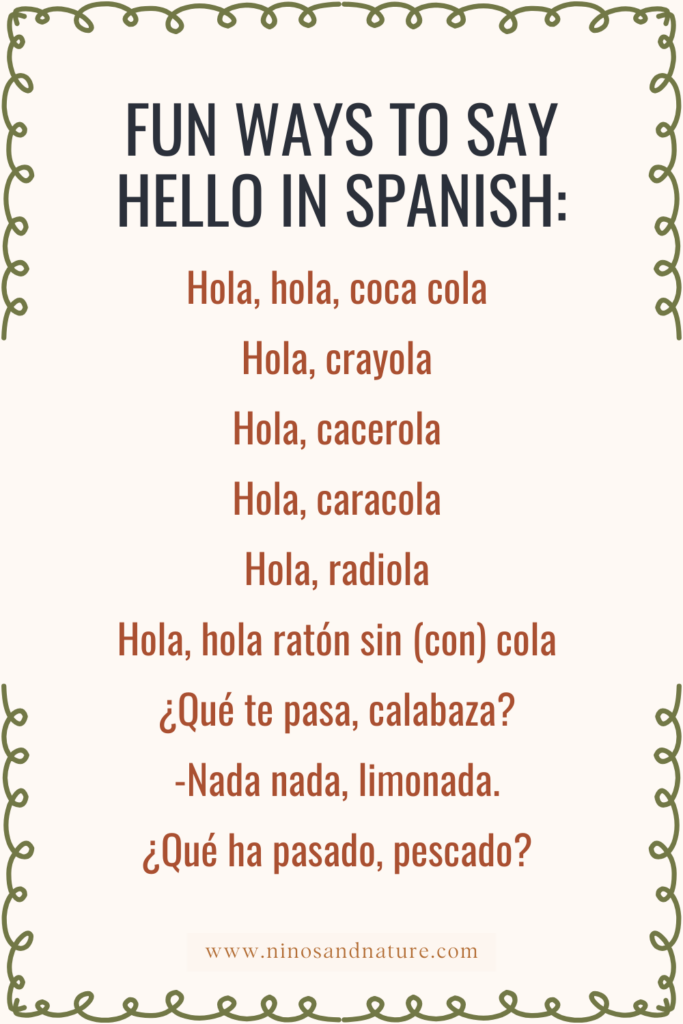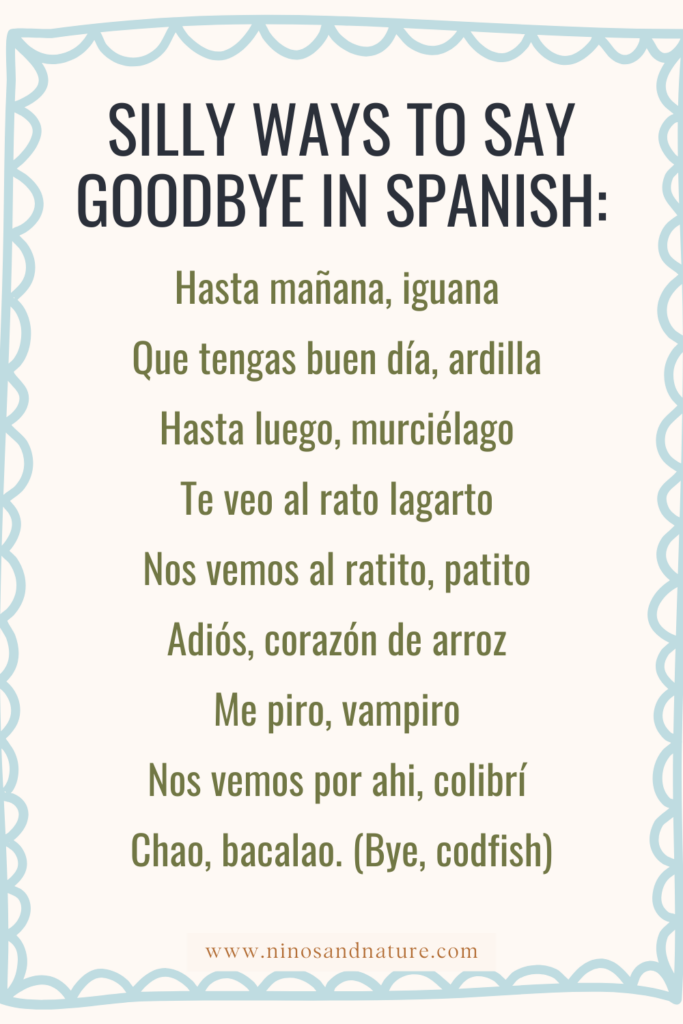
30 Fun Spanish Greetings: Silly Rhymes in Spanish for Kids
In this post: Learn 30 silly Spanish greetings and fun Spanish expressions for kids. Post contains affiliate links.
If you’re looking to add some playful elements to your child’s Spanish learning journey, you’ve come to the right place. Practicing fun Spanish greetings and whimsical ways to say goodbye in Spanish can make learning both engaging and effective.
As we all know, kids love to laugh and play with words. Why not channel that natural curiosity into getting playful with their Spanish lessons? In today’s post, we’ll explore silly Spanish greetings, fun expressions, and amusing farewells that are sure to delight your little ones.
Let’s dive into these rhyming Spanish expressions and bring some extra smiles to your language learning with your kids!
Table of Contents
Playful Spanish Greetings for Kids
It’s time to go beyond the basic “hola” and add these fun rhyming Spanish greetings to your day. There are so many fun ways you can say hello in Spanish to friends and family! Many of them are simple rhymes making absolutely no sense using the word hola. Kids all around the world use with fun Spanish rhymes and greetings their buddies!
Remember this blog is equipped with text to speech in Spanish! Simply highlight and phrase you want to hear read aloud, then click the blue speaker icon to listen and learn.
Let’s jump in and learn some fun Spanish greetings for kids!
- Hola, hola, coca cola (hello, hello, Coca Cola)
- Hola, crayola (hello, crayon)
- Hola, cacerola (hello, pan)
- Hola, caracola (hello, shell)
- Hola, radiola (hello, jukebox)
- Hola, hola ratón sin (con) cola (hello, hello, mouse without (with) a tail)
- ¿Qué te pasa, calabaza? -Nada nada, limonada. (What’s up, pumpkin? -Nothing, nothing lemonade)
- ¿Qué ha pasado, pescado? (What’s happened, fish?)

Saying Goodbye in Spanish with Silly Rhymes
Now let’s expand our Spanish farewells and learn fun rhymes to help us say goodbye en español! You can teach your children one at a time, or read them the whole list and let them pick their favorites. Don’t forget to remind your children that these are silly and informal! They’re best used with friends that you know well.
- Hasta mañana, iguana (see you tomorrow, iguana)
- Que tengas buen día, ardilla (Have a good day, squirrel)
- Hasta luego, murciélago (see you later, bat)
- Te veo al rato lagarto (See you later lizard)
- Nos vemos al ratito, patito (See you in a bit, little duck)
- Adiós, corazón de arroz (goodbye, heart of rice)
- Me piro, vampiro (I’m heading out, vampire)
- Nos vemos por ahi, colibrí (We’ll see each other around, hummingbird)
- ¡Chao pescao! (Bye, fish!)
- Chao, bacalao. (Bye, codfish)
- A la cama, llama (Go to bed, llama)
- Hasta mañana, banana (See you tomorrow, banana)

More Spanish Rhymes for Kids
These aren’t necessarily greetings or goodbyes, but I wanted to share even more silly Spanish rhymes that kids love! It can be so hard to get kids excited about learning Spanish, and I always find that bringing in a playful and whimsical element (like these rhymes) really helps! It’s an easy and low-stress way to practice Spanish with kids and can become a great part of your routine.
- Estoy feliz como una lombriz. (I’m as happy as a worm)
- Bien dicho, bicho. (Well said, bug)
- Me extraña, araña. (How surprising, spider)
- De nada, empanada. (You’re welcome, empanada)
- No sé, José. (I don’t know, José)
- ¿Qué te parece, trece? (What do you think, thirteen?)
- A otra cosa, mariposa (To the next thing, butterfly)
- Qué nivel, Maribel. (Next level, Maribel)
- Ya te digo, Rodrigo. (I’m telling you, Rodrigo)
- Más feliz que una perdiz. (Happier than a partridge)
Spanish Rhyme Books for Kids
If you’re wanting to learn even more rhymes in Spanish with your kids, check out some of my favorite bilingual books to help us learn at home.
Benefits of Learning Spanish Rhymes with Kids
Learning fun Spanish rhymes isn’t just a silly way to learn a language with kids. It offers a myriad of benefits that go beyond just making them laugh. Let’s explore how these playful Spanish expressions can positively impact memory, engagement, and overall language acquisition in children:
Memory Boost: Fun and silly phrases often stick in the mind more effectively than traditional vocabulary. The playful nature of these expressions triggers different areas of the brain, making them easier to recall. As a result, your child is more likely to remember and use these phrases in their conversations.
Increased Engagement: Language learning becomes more enjoyable and interactive when it involves playful elements. Fun Spanish expressions capture your child’s attention and keep them engaged in the learning process. Whether it’s through rhymes, wordplay, or humorous expressions, these phrases make language acquisition an enjoyable experience.
Enhanced Pronunciation Practice: Many of these silly phrases in Spanish contain unique sounds and rhythms that provide valuable pronunciation practice. By repeating these phrases aloud, your child develops their oral skills and becomes more comfortable with Spanish pronunciation.
Confidence Building: Using fun and silly Spanish greetings encourages experimentation and creativity in language use. As your child becomes more confident in expressing themselves with these playful expressions, they’re more likely to take risks and engage in conversations in Spanish with greater confidence.
By incorporating fun and silly Spanish greetings into your child’s language learning routine, you’re not just teaching them words – you’re fostering a love for language and igniting their curiosity to explore the world of Spanish with joy and enthusiasm.
Fun Spanish Lessons for Kids

If you’re wanting more fun, outside-the-box ways of teaching your children Spanish, don’t miss my hands-on Spanish curricula for kids of all ages!
Whether you’re looking for a play based Spanish preschool curriculum for beginners, an early years nature inspired Spanish curriculum for bilingual families that goes beyond the basics, or maybe a hands-on way to get teenagers and older kids excited about learning Spanish – don’t miss the Niños & Nature Curriculum Shop to find the perfect Spanish learning companion to match your unique and wonderful family.
That’s all I have for you today families! I hope you love using these fun Spanish greetings and rhymes with your children, and I hope they bring as much joy into your home as they do into mine. ¡Chao, pescao!
Like this post? Share & Save it!














